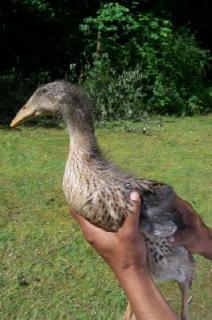I have one young runner that is supposedly "fairy fawn". If he is indeed that color, what would be his genetics? I hatched him from a batch of eggs that were supposed to be pure trout runners. He's about 5 weeks old now, and his 5 brothers (sisters?) are deffinately trout...... They all came from the same pen.
He was dark brown with an almost black beak and feet when he was born, and now he's lightened up considerably, but has no eye stripes or neck ring. He's also got a bit of a "roman nose". His feet and beak have turned orange. His head is dull grayish-brown, and his body feathers look like those of my other trout runners, only with less light color on the chest.
Could he be dusky? Is "Fairy fawn" a light phase dusky? Since dusky is incompletely dominant, wouldn't it have shown up in one of the parents? (I didn't see the parents.... ordered the eggs on-line).
Thanks in advance.....
Lisette
He was dark brown with an almost black beak and feet when he was born, and now he's lightened up considerably, but has no eye stripes or neck ring. He's also got a bit of a "roman nose". His feet and beak have turned orange. His head is dull grayish-brown, and his body feathers look like those of my other trout runners, only with less light color on the chest.
Could he be dusky? Is "Fairy fawn" a light phase dusky? Since dusky is incompletely dominant, wouldn't it have shown up in one of the parents? (I didn't see the parents.... ordered the eggs on-line).
Thanks in advance.....
Lisette




